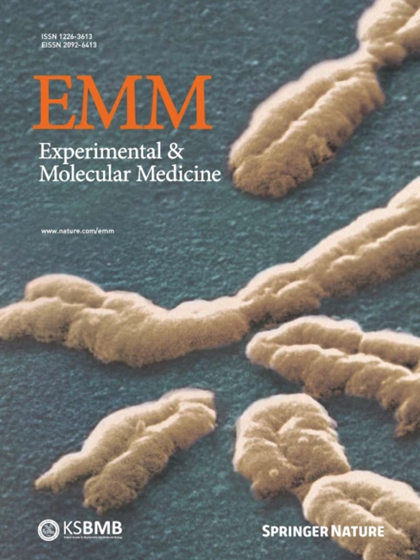棕色脂肪特异性过表达 RBP4 可通过激活典型肾上腺素能信号通路改善体温调节和全身代谢。
IF 9.5
2区 医学
Q1 BIOCHEMISTRY & MOLECULAR BIOLOGY
引用次数: 0
摘要
视黄醇结合蛋白 4(RBP4)是血液循环中视黄醇(维生素 A)的唯一特异性载体,在肝脏和脂肪组织中高度表达。以往的研究表明,RBP4 在冷介导的脂肪组织褐变和产热过程中发挥作用。然而,RBP4 在棕色脂肪组织中的作用及其代谢意义仍不清楚。在这里,我们生成并研究了表达人类 RBP4(hRBP4)的转基因小鼠(UCP1-RBP4 小鼠),特别是在棕色脂肪细胞中,以更好地了解这些不确定性。这些小鼠在进食杂粮时,体重和脂肪量明显低于同窝对照组。UCP1-RBP4 小鼠的葡萄糖清除率也有明显提高,能量消耗增加,在应对寒冷挑战时产热增加。这与棕色脂肪组织中脂肪分解和脂肪酸氧化的增加有关,而脂肪分解和脂肪酸氧化的增加归因于典型肾上腺素能信号通路的激活。此外,高效液相色谱分析显示,UCP1-RBP4小鼠血浆中的RBP4和视黄醇水平升高,而肝脏中的视黄醇水平则随着进食而下降。UCP1-RBP4 小鼠棕色脂肪中总视黄醇的稳态水平明显升高,这表明在以粗饲料喂养时,RBP4 表达的棕色脂肪细胞对视黄醇的吸收增加。这些发现揭示了 RBP4 在肾上腺素能信号传导中的关键作用,肾上腺素能信号传导可促进棕色脂肪细胞中的脂质动员和氧化,所利用的能量通过适应性产热以热量的形式散失。本文章由计算机程序翻译,如有差异,请以英文原文为准。

The brown fat-specific overexpression of RBP4 improves thermoregulation and systemic metabolism by activating the canonical adrenergic signaling pathway
Retinol-binding protein 4 (RBP4), the sole specific carrier for retinol (vitamin A) in circulation, is highly expressed in liver and adipose tissues. Previous studies have demonstrated that RBP4 plays a role in cold-mediated adipose tissue browning and thermogenesis. However, the role of RBP4 in brown adipose tissue and its metabolic significance remain unclear. Here we generated and studied transgenic mice that express human RBP4 (hRBP4), specifically in brown adipocytes (UCP1-RBP4 mice), to better understand these uncertainties. When fed a chow diet, these mice presented significantly lower body weights and fat mass than their littermate controls. The UCP1-RBP4 mice also showed significant improvements in glucose clearance, enhanced energy expenditure and increased thermogenesis in response to a cold challenge. This was associated with increased lipolysis and fatty acid oxidation in brown adipose tissue, which was attributed to the activation of canonical adrenergic signaling pathways. In addition, high-performance liquid chromatography analysis revealed that plasma RBP4 and retinol levels were elevated in the UCP1-RBP4 mice, whereas their hepatic retinol levels decreased in parallel with a chow diet. Steady-state brown fat levels of total retinol were significantly elevated in the UCP1-RBP4 mice, suggesting that their retinol uptake was increased in RBP4-expressing brown adipocytes when fed a chow diet. These findings reveal a critical role for RBP4 in canonical adrenergic signaling that promotes lipid mobilization and oxidation in brown adipocytes, where the harnessed energy is dissipated as heat by adaptive thermogenesis. Brown adipose tissue, or brown fat, helps generate heat in our bodies. This study explores how retinol-binding protein 4 affects the ability of brown fat to burn energy. The researchers used mice genetically modified to produce more RBP4 in their brown fat. They found that these mice had lower body weight and better glucose control compared with normal mice. The study involved analyzing the mice’s fat tissues and measuring their energy use and fat breakdown. The researchers discovered that increased RBP4 in brown fat led to higher energy expenditure and improved fat metabolism. This suggests that RBP4 plays a role in activating brown fat and could help in managing obesity and related metabolic disorders. The findings indicate that targeting RBP4 in brown fat might be a potential strategy for treating obesity. This summary was initially drafted using artificial intelligence, then revised and fact-checked by the author.
求助全文
通过发布文献求助,成功后即可免费获取论文全文。
去求助
来源期刊

Experimental and Molecular Medicine
医学-生化与分子生物学
CiteScore
19.50
自引率
0.80%
发文量
166
审稿时长
3 months
期刊介绍:
Experimental & Molecular Medicine (EMM) stands as Korea's pioneering biochemistry journal, established in 1964 and rejuvenated in 1996 as an Open Access, fully peer-reviewed international journal. Dedicated to advancing translational research and showcasing recent breakthroughs in the biomedical realm, EMM invites submissions encompassing genetic, molecular, and cellular studies of human physiology and diseases. Emphasizing the correlation between experimental and translational research and enhanced clinical benefits, the journal actively encourages contributions employing specific molecular tools. Welcoming studies that bridge basic discoveries with clinical relevance, alongside articles demonstrating clear in vivo significance and novelty, Experimental & Molecular Medicine proudly serves as an open-access, online-only repository of cutting-edge medical research.
 求助内容:
求助内容: 应助结果提醒方式:
应助结果提醒方式:


